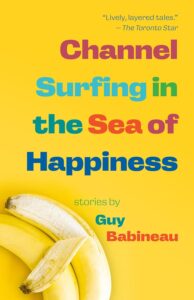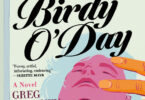Guy Babineau, Channel Surfing (Cormorant Books, 2024), 272 pp., $24.95.
With a gift for potent characterization, a penchant for quirky detail, and a deep sense of LGBTQ2S+ history, Channel Surfing in the Sea of Happiness, the debut short-fiction collection from Vancouver-based author Guy Babineau, offers the reader a richly textured reading experience. Brilliantly using the past to comment upon contemporary queer lives, Channel Surfing is stunning collection of moving, clever, witty stories with a delicious cast of queer (and not so queer) characters set in Toronto and Vancouver—with brief stops in Chicago, Las Vegas, Cleveland, and Detroit. And the book itself has a unique backstory as well.
Babineau, who was founding editor of the glossy gay lifestyle magazine LOV (Living Out Vancouver), has been writing and publishing since 1986, when his first short story appeared in the seminal gay journal The Body Politic. Other short fiction followed, in literary publications like Descant and The Church Wellesley Review. But eventually Babineau’s focus moved to journalism—notably for the Vancouver weekly The Georgia Straight as well Toronto’s queer tabloid Xtra!, for whom he wrote a celebrated, in-depth 2004 article debunking the myth of Patient Zero (the Québécois flight attendant Gaëtan Dugas, whose possible role in the early spread of HIV in North America was sensationalized in the Randy Shilts book And the Band Played On.)
Channel Surfing was originally slated to be published in November 1998 by Sam Hiyate’s indie publisher Gutter Press—which published some of the most edgy, risk-taking writers of the late 1990s, including Derek McCormack (Dark Rides and Wish Book), Bruce LaBruce (The Reluctant Pornographer), Tamara Faith Berger (Lie with Me) and John L’Ecuyer (Use Once and Destroy). Review copies were sent out, and the literary trade publication Quill & Quire wrote a glowing review, but Gutter went bankrupt just before the book was to be distributed—and Babineau stopped writing fiction.
But when Marc Coté, publisher of Cormorant Books, expressed interest in the collection, Babineau saw it as a chance to revisit the stories, after more than twenty years had passed. He ended up re-writing them. In an email, Babineau told me, “It was an opportunity to complete the collection properly and align the stories with what’s happening today—although they’re set in the seventies, eighties and nineties. Like we did in the eighties during the worst years of AIDS.” Looking at the manuscript, he axed two stories he felt no longer fit and added three new ones: “Mister Makeup,” “The Prayers of Miss Atomic Blast,” as well as “The Emperor’s New City,” ultimately one of the most thrilling stories in the book.
In that story, we’re given a devastating portrait of Vancouver’s LGBTQ2S+ community in the late 1990s and early 2000s. It’s a Vancouver where the queer community is under attack. Homophobia and gay-bashing are on the rise. The city is plagued with racism. The past is threatened by gentrification; homelessness, IV drug use, and poverty are being ignored. It’s a city we see through the eyes of no-nonsense Pussy Esperanto, a trans sex worker who makes it big with her memoir, The Indelible Woman. But Pussy’s success can’t protect her from the insidious violence on the loose; her friends and colleagues, her family, and her community are all in danger. But she fights back—and she’s not the only one. It’s hard for these characters to feel safe, but in this story, they are not going down without a fight.
Babineau’s approach to the issue of queer identities will linger with readers long after they finish the book. Within its pages, we bear witness to how being LGBTQ2S+ has been covered on screen and in the media—Rock Hudson, David Bowie and Liberace all make appearances. Central to Channel Surfing is a quartet of gently linked narratives that focus upon the teenage trials and tribulations of Trevor, a bullied queer teen growing up in the seventies. We are introduced to Trevor in “Chairman Mao and the Spiders from Mars,” the collection’s opening story. As Babineau guides us through Trevor’s life, we witness his finding security in his partnership with Ian, his diagnosis as HIV-positive (“Why God Forgives Our Sins” and “Mister Makeup”), and ultimately his death (“Heart Deco”). Reading these stories, we stand witness to loss and pain, grief and trauma. But the stories aren’t strictly limited to LGBTQ2S+ lives—and they are marked by thematic preoccupations with family and friendship, love and remembrance.
What really stands out in these nine stories are the wonderfully quirky details that Babineau uses to perfectly situate his engaging narratives. When he takes us to a seedy movie theatre in Vancouver where Bowie-smitten teenager Trevor goes to see Visconti’s Death in Venice with his seemingly more sophisticated friend Rose, we smell its off-putting musky rankness and the “creaky, uncomfortable seats covered in ripped velveteen.” We sympathize with Trevor’s reading of the film, which he deems “pretty boring. Nothing much happened… It was basically an all stalk, no action movie.” In a series of three linked stories about a pair of queer Canadian con artists, Babineau has them heading back to Canada with a van-load of valuable vintage typewriters, but lets them pause at a wig store in Detroit where one of the pair, Monsieur Delacroix, buys a supply of nail polish called Hard Candy, “in the gunmetal grey shade of Ghetto Girl he insisted was flattering on him.” There’s a razor-sharp wit at play here, too; in “The Food Chain,” in the swank lobby of an office tower in Yorkville, we discover that Doreen, coming to meet a sponsor for the AIDS gala she’s organizing, is “ushered upstairs by an older gentleman wearing an impeccably tailored three-piece suit. He had the fastidious wrists of a sissy in a 1930s movie. A thin-haired comb-over swirled around his scalp like a Japanese sand garden.”
Babineau has a keen eye for the absurd. The trip to the Liberace Museum in “The Prayers of Miss Atomic Blast,” the book’s final story, is particularly delightful. So is the conversation in “Heart Deco” where the aforementioned Doreen tells her parents that that Trevor’s boyfriend Ian is the sperm donor for her child! Throughout the collection, Babineau shares distinctive details about his characters that make us want to know more about them—such as the pair of purple satin pants worn by Trevor in “Chairman Mao and the Spiders from Mars,” which he believes will bedazzle David Bowie. Grifter extraordinaire Monsieur Delacroix, from the con-artist trilogy of tales, is characterized by self-consciously clever quips, madcap malapropisms and wacky theories, shared with a seriousness at once ludicrous and mesmerizing. His unnamed partner-in-crime carefully records Delacroix’s hypotheses for posterity, including a dazzling pontification on elevators. Babineau is not afraid to expose his characters’ foibles, and that is one of the collection’s many strengths—it’s what makes them come to life.
Here is a representative passage from the collection’s final story that showcases Babineau’s inventive and evocative style. Its title, “The Prayers of Miss Atomic Blast,” is drawn from Las Vegas history (Miss Atomic Blast was the title that in 1952 was bestowed upon Candyce King, a dancer at its local Last Frontier Hotel, at a time when Vegas was dubbed “Atomic City.”) The story is situated near the site of many atomic-bomb tests that took place in 1950s Nevada.
Two days later, Monsieur and I sat on a rock across from the Hoover Dam, waiting for a truck to fall. In Vegas, when you’re on a roll, you don’t stop. After Elysium, we went to some other saloons off the beaten track, but my interest in seeing the real Las Vegas eventually waned. So, I persuaded Monsieur to cross the desert with me. Lake Mead was a forty-five-minute drive. We brought a picnic hamper and a couple of bottles of Cristal.
After finding out about Miss Atomic Blast, I did some reading up about nuclear testing in Nevada. About the myriad cancers of thousands of downwinders. About the trillions of litres of radioactive water bubbling beneath the desert floor. And about the trucks crossing the Hoover Dam. Every day, several trucks carrying nuclear waste traversed the narrow road on top of the dam. If one fell, all hell would break lose. I wanted a front-row seat when it did.
We arrived just in time for daybreak. I cracked open one of the bottles and poured us each a glass. We clinked rims while we watched the sun rise. I took Monsieur’s hand. I’d finally accepted that we were stuck with each other. We were in a holding pattern that only oblivion could end.
Key aspects of Channel Surfing’s power and effectiveness include its wide-ranging cast of characters—in particular, exceptionally empathetic portraits of people experiencing homelessness—and the sheer range of queer experiences that are explored. There are one-night stands and long-term partnerships, seedy gay bars and bathhouses, and hustling on the streets of Vancouver; the book includes some deliciously playful hookups. Babineau’s delightful sense of humour, his way of drawing us so fully into the worlds of his characters and, perhaps most important, his ability to bring queer history to life all contribute to a deeply satisfying reading experience.
 Jeffrey Canton began his freelance career interviewing queer writer Patrick Roscoe for Xtra! in 1990, writing features on LGBTQ2S+ creators including Makeda Silvera, Timothy Findley, Jeanette Winterson, Peter McGehee, and Doug Wilson, and later writing the newspaper’s “Between the Covers” column. He’s currently the Children’s Books columnist for The Globe and Mail.
Jeffrey Canton began his freelance career interviewing queer writer Patrick Roscoe for Xtra! in 1990, writing features on LGBTQ2S+ creators including Makeda Silvera, Timothy Findley, Jeanette Winterson, Peter McGehee, and Doug Wilson, and later writing the newspaper’s “Between the Covers” column. He’s currently the Children’s Books columnist for The Globe and Mail.







